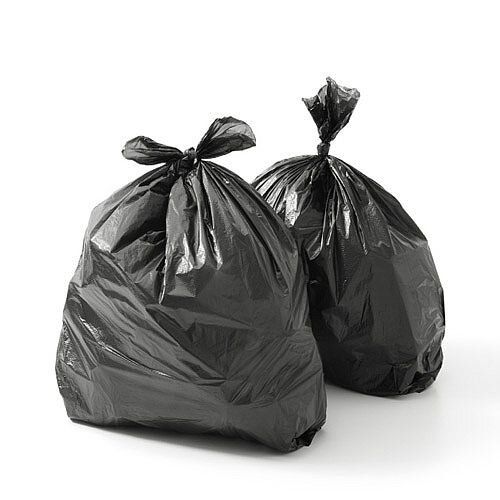CHOOSING THE RIGHT REFUSE SACKS

Confused by the technical jargon or buying refuse sacks, or are you buying a sack which is too strong for your application? This 3 step-guide helps to simplify the jargon to help you chose the right type, size and thickness.
Step 1 - Choose the type required
Where is the waste going to end up?
· If it is going to compost, you will need a compostable sack.
· If it is going to landfill:
- High security waste (especially in public spaces etc.) Use clear sacks.
- General/Domestic Waste - either a black sack or if it is part of a recycling scheme you may want coloured sacks.
- Industrial use - Extra heavy duty black sacks or compactor sacks (compactor sacks are available in both black and clear).
Step 2 - Calculate the size you need
To calculate which size refuse sack is needed for your bin, just use these simple formulas. Round Bin Width of sack= Radius of bin x π (3.14) Length of sack= Length of bin + approx. 15cm for overhang and tying Length Radius Rectangular/Square bin Width of sack= width + depth of bin Length of sack= Height of bin + approx. 15cm for overhang and tying
How does the sizing work on a sack?
A lot of bin liners are shown as three sizes for example 18x29x39”
This is how it works:
- The first measurement i.e. the 18 is the bottom gusset of the bag, useful if this is approximately the diameter of a round bin or width of a square bin.
- The second measurement, i.e. the 29 is the top measurement of the sack, double this makes the circumference of your bin top
- The third measurement is the length of the sack from bottom to top! This is where you need the extra to tie or fold over on your bin or sack holder!
Step 3 - Choose your Thickness
Not necessarily, so this is where testing comes in. CHSA have devised a scheme to make it easier to understand. Previously it was gauge or micron thickness. Another method is to check the weight of your sacks
Consider what kind content will go in the sack. For example, if you know you are going to have heavy refuse then you will need a strong, durable sack, so you will need a 20 kg sack. If it will be used just for paper or other light weight items, you only need a 5 kg sack.
Here are some general examples:
- 5kg - Paper/General Office Waste
- 10 kg - Domestic Refuse and Recycling
- 15 kg - Catering Food Waste
- 20 kg - Industrial Waste
Benefits of Using Refuse Sacks
One of the most lucrative benefits of switching to refuse sacks made from recycled plastics is the ability to reduce your facility's carbon footprint. By using refuse sacks made from PCR HDPE or PCR LDPE resins, you can help prevent the processing of finite fossil fuels. And when these fossil fuels are burned and processed, they release a myriad of harmful greenhouse gases that helps contribute to global warming.
The Environmental Protection Agency estimates the burning of fossil fuels was responsible for 79% of the greenhouse gases emitted in the U.S. in 2010. At the same time, the EPA reports using PCR resins are the greener and more environmentally conscious decision. When your business uses refuse sacks made from recycled plastics, you'll help
· Reduce the amount of oil utilized in the development of virgin plastics
· Lower CO2 emissions associated with the production of virgin plastics
· Help prevent refuse sacks made from virgin resins from ending up on landfills
· Limit the consumption of energy associated with the creation of plastics
For buying quality refuse sacks visit us here




